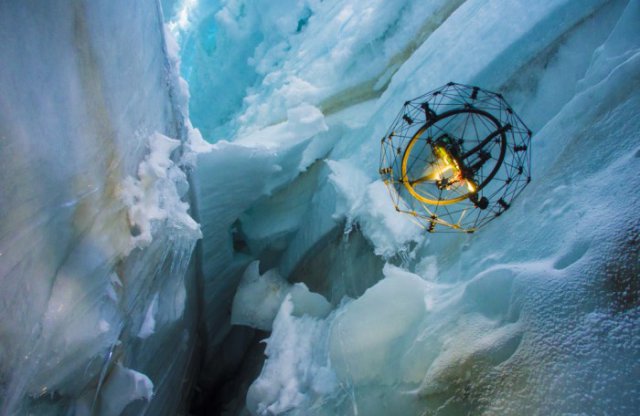Search and Rescue: The term conjures images of dangerous work under stressful conditions with high stakes at hand. In the future, drones will likely be a tool for SAR professionals, perhaps something like a crevasse-penetrating concept. Flyability, an industrial drone manufacturer, released the video below, showing a UAV probing a crevasse in a SAR scenario.
As even the unfamiliar can probably surmise from the video, crevasses are very dangerous places. Found commonly on glaciers, crevasses can plummet hundreds of feet into the ice. They are often covered by thin snow bridges, which can give way when people walk on them, making glacier travel a hazardous endeavor.
Searching for a survivor of a crevasse fall is also a daunting and dangerous task, one this UAV may help simplify.
As reported by Flyability, which partnered with the mountain rescue team of the Zermatt Glacier in the Swiss Alps on the project:
“This successful experience has shed light upon the promising results of using this game-changing device for mountain Search & Rescue missions, in addition to the current focus of the company in Industrial Inspection of inaccessible and confined environments. The technology has been warmly welcomed by Zermatt rescue professionals as they are constantly developing and refining rescue techniques, which reach the highest efficiency in crevasse fall emergencies, to locate injured parties before dispatching a rescue team in dangerous situations.”
Could drones be a solution to other Search And Rescue scenarios, particularly in terrain with other hazards such as floods, avalanches, or fires?
“I’ve seen some discussion on the use of drones in SAR. Seems like feelings are mixed.” said Randy Felix, VP of Crested Butte Mountain Rescue. “It could be a useful tool for gathering information, getting a lay of the land, and possibly assisting in searching difficult terrain.”
Felix said drones could add a tool to the box for rescue personnel, but that they have limitations right now. Cost, getting the drone to a location where it can be deployed, access to skilled pilots, the dangers of drones being used around helicopters, and mountain weather are among some of the drawbacks to drone use.
“Having said all that, under the right circumstances and the right mission it could be useful. It could help to increase the probability of detection in a given search area in conjunction with traditional Search And Rescue techniques. SAR teams need to be aware of new technology and have open minds when it comes to these types of things.”
Drone Advancements For SAR
Flyability’s latest drone is capable of descending into glaciers thanks to a unique design that protects rotors during flight.

A spherical, freely rotating protective cage keeps the drone stable after contact with ice walls, making it collision-tolerant and “safe to fly close to humans.”
In the above video, it was capable to easily access the glacial environment while being remotely operated by an untrained pilot. The embedded full HD camera, digital live video transmission and the powerful lighting system allowed the drone to operate in the heart of the mountain glacier, tens of meters below the surface.
What other environments may be explored with advances in technology, from windy to smoky to snowy; seem to be limited only by the creativity of engineers.
Source: Gear Junkie

